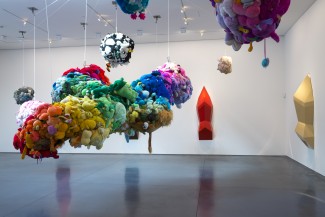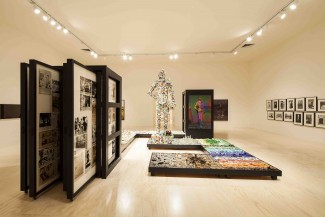LAST DAY: ‘Mike Kelley’ set to close Feb. 2 at MoMA PS1

NEW YORK — The enormous and engaging retrospective of Mike Kelley’s artistic output will come to a close Sunday, Feb. 2 at the Museum of Modern Art’s PS1 building in Long Island City, Queens. After gracing the walls of this old educational building, the exhibition heads to MOCA in Los Angeles for a multi-month run.
“Mike Kelley,” the largest display of the late artist’s work, has been organized by Stedelijk Museum, Amsterdam, and after walking through the many rooms and hallways of PS1, it’s clear the curators have focused on the word exhaustive. Room after room shows Kelley’s unique qualities and recurring themes. By placing these pieces of art next to one another, showcasing more than three decades of work, spectators can start drawing conclusions about the controversial artist, about his motivations and anguish.
Many of the images are unforgettably haunting, especially the installation known as “Day is Done,” which takes up an entire gymnasium-sized room. The piece couples many startling images and blaring sounds. There are projections that switch places, a lonesome bathroom stall, a scaled-down version of a suburban home and what sounds like the cackle of a witch. Videos shine everywhere, giving three-dimensionality to still photographs, extrapolating full dramas from simple images.
The “John Glenn Memorial Detroit River Reclamation Project (Including the Local Culture Pictorial Guide, 1968-1972, Wayne/Westland Eagle),” despite its long name, is one of the more accessible pieces in the collection. A gargantuan sculpture of the iconic astronaut stands in the middle of the room, brought to awkward life by reclaimed and broken objects from the Detroit River. The exhibition is in remembrance of the 300th anniversary of Detroit, location of Kelley’s upbringing. Surrounding Glenn is a small maze of multicolored glass and forgotten bits, all meticulously cleaned and ordered.
In these mazes of broken objects one can find similarities with the patterned displays of jewelry, pins, name tags and other found objects that Kelley exhibited in the “Memory Ware” series. MoMA smartly places these two rooms next to each other on the third floor. “Endless Morphing Flow of Common Decorative Motifs (Jewelry Case)” groups together similarly found objects.
“Rose Hobart II” is an interactive exhibit that invites viewers to become voyeurs and watch the 1980s comedy Porky’s through a peephole, recreating the scene from the movie. “Pay for Your Pleasure” is a long hallway of colorful portraits of important literary and academic figures. Their faces are capped by quotes that tie the art world with the criminal world. One of the more fascinating rooms features Kelley’s early birdhouse series. These wooden constructions are less realistic abodes for fowl and more humanistic creations; they are attempts at wayward invention, offering perceived easy and hard roads for resting birds.

Kelley’s most iconic and popular works involve the stitching together of generic stuffed animals. “Deodorized Central Mass with Satellites” is the piece that receives the most fanfare. Stuffed-animal satellites hang around a “central mass” of fluffiness. Surrounding the animals are futuristic deodorizers that sanitize the air every few minutes. “Half a Man,” located on the second floor, uses similar materials.
“Educational Complex” features architectural aspects from every school that Kelley attended. The artist was apparently attracted (and perhaps plagued) by the past, showcasing his feelings and also commenting on repressed memories. The school complex is a gigantic construction of white rooms and layered roofs; it’s essentially a new complex, but one made from stitched-together memories.
“Extracurricular Activity Projective Reconstruction #1 (A Domestic Scene)” is one of the many films that viewers can watch throughout the exhibition. “Domestic Scene,” running little less than 30 minutes, is also featured in MoMA’s main Manhattan building.
I found myself the most involved with Kelley’s “Kandor” project, a series of pieces depicting the infamous city from Superman’s Krypton that has been shrunk and encased in glass. Kelley was apparently fascinated by this miniature world and set out to create different versions of the metropolis. MoMA PS1 displays each construction in darkly lit rooms, adding to the eerie effect of seeing these cities under bright-colored glass.
“From My Institution to Yours,” which can be seen from the first floor and basement, is a monument recognizing class divides. A clenched fist is surrounded by cartoon characters and union speech. A solitary red ribbon connects the piece with an “Employees Only” room and battering ram down the hallway. Luckily, an accompanying summary fills in the symbolic blanks.
The basement, in addition to housing “From My Institution to Yours,” also includes film screenings. MoMA PS1’s dank and chilly boiler room is even included as a display room.
“Mike Kelley” is an intriguing combination of artistic expression, highlighting pieces that elicit admiration and scrutiny. Kelley, who died in 2012, coupled innovation with memory, working across many styles and forms. I’m not sure MoMA PS1 will ever be the same again.
By John Soltes / Publisher / John@HollywoodSoapbox.com
-
“Mike Kelley” continues at MoMA PS1 through Feb. 2. The exhibition includes mature content. The next stop for the retrospective is MOCA in Los Angeles. Click here for more information.

